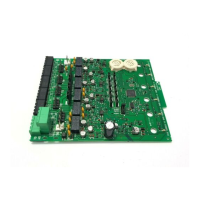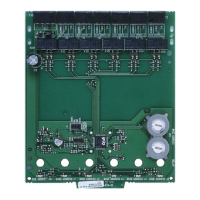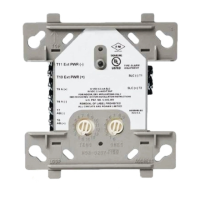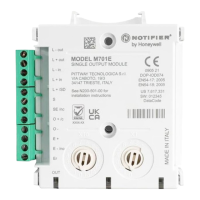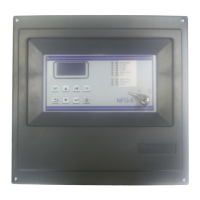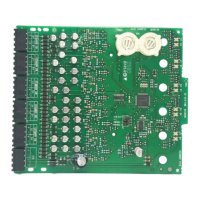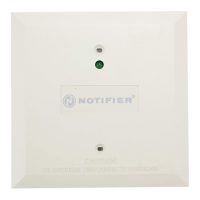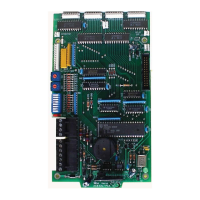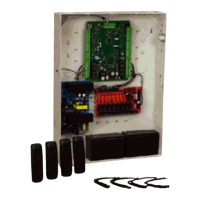SCS Series Manual — P/N 15712:L 7/18/16 65
Configuration The SCS⁄SCE
Manual Control
Manual actions may be taken to override the automatic functions. Moving any switch on the SCS⁄SCE out of the automatic position
(ON/OFF) will cause the FSCS to enter the manual control state. In this state, any further automatic operation is inhibited for the respective
SCS⁄SCE.
According to the requirements of NFPA 92A, after the first alarm, automatic operation will be inhibited for the entire FSCS. Manual inter-
vention is then required to make any changes to the state of smoke control points.
All smoke control elements (fans, dampers, etc.) must be installed with and provide feedback from all control and monitor points present in
the toggle switch group type. Non-dedicated Systems use feedback to monitor system operation when the SCS⁄SCE is in manual mode only.
If the correct feedback is not received within the specified delay time, trouble will be indicated within the toggle switch group and at the
FACP or Network Control Annunciator. The trouble condition requires acknowledgment to silence the sounders at the FSCS and FACP or
Network Control Annunciator.
• Existing/legacy SCS installations (includes Mode A): Systems may be returned to the automatic condition by placing all SCS⁄SCE
switches into the AUTO position and resetting the panel. Resetting the FACP and/or Network Control Annunciator is required after
manual operation in Dedicated Systems and after a fire alarm condition in all systems. Reset of the FACP and/or Network Control
Annunciator will be inhibited until all SCS/SCE switches are returned to the AUTO position.
• NFS2-3030/NCA-2 Mode B systems: Refer to Appendix C.2, “Mode B Operation”.
3.8.2 Heating, Ventilating & Air Conditioning (HVAC) Mode
The HVAC Mode is enabled when dipswitch six on the SCS is in the OFF position (see Table 3.4). The main difference between the FSCS
mode and the HVAC mode is the fact that the HVAC mode does not require both the control and verification of a particular device. For
instance, in the HVAC mode a switch group can have the capability to open a damper but it does not have to verify whether it is open or
closed. This difference adds six scenarios to the nine already defined. These 15 scenarios or switch group types are shown in .
In this mode, the piezoelectric sounder will never be activated. This mode of operation is not consistent with the UL and NFPA standards for
Smoke Control Mode and should be used for HVAC and Non-Smoke Control purposes only. To ensure proper operation, it is important to
correctly install the SCS⁄SCE associated control and monitor modules.
For fan control, the FACP would typically use two control modules for control and one monitor module to monitor. (The monitor module
may be eliminated if no verification is desired). The switches can perform basic functions with only one control module and no monitor
module, however, the switch will not be capable of true ON/AUTO/OFF control. For example, if only ON control is provided the activation
of the CON
ON⁄OP
CM will activate the device. Upon deactivation of the control module there is no guarantee the device will be deactivated.
Either automatic operation or Manual OFF control must be sacrificed with only one control module.
NOTE: A graphic representation for the location and function of each switch is to be mounted adjacent to the FSCS. This graphic
representation must clearly identify each switch.
NOTE: HVAC mode is not a listed Smoke Control function and should never be used as such. This is the only mode supported from the
INA and the NFS-320 and NFS2-640
Refer to the “Restrictions” section of this manual for information on compatible software part numbers.
NFS-320, NFS2-640, NFS-640, NFS2-3030, NFS-3030, NCA and NCA-2s are only compatible with SCS software #SCS2.84 or higher. They
are not compatible with any 73XXX series software versions.
To use the SCS V4.0, NFS2-3030, and/or NCA-2 must be running software V21 or higher.
Table 3.9 HVAC Mode Switch Group Types
1 VER
OFF⁄CL
Verify when the fan is off (damper closed)
2 VER
ON⁄OP
Verify when the fan is on (damper open)
3 VER
ON⁄OP
and VER
OFF⁄CL
Verify when the fan is on and off (damper open and closed)
4CON
OFF⁄CL
Turn a fan off (close a damper)
5CON
OFF⁄CL
and VER
OFF⁄CL
Turn a fan off (close a damper) and verify when the fan is off (damper closed)
6CON
OFF⁄CL
and VER
ON⁄OP
Turn a fan off (close a damper) and verify when the fan is on (damper open)
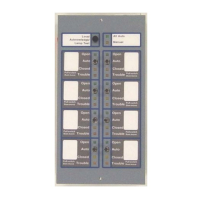
